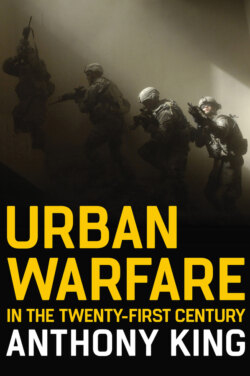Читать книгу Urban Warfare in the Twenty-First Century - Anthony King - Страница 13
Interstate War
ОглавлениеWhen scholars invoke demographics and asymmetry, they have been mainly concerned with explaining urban insurgencies and civil conflict.15 This is not unreasonable; most urban battles this century have occurred as part of civil conflicts. Nevertheless, these scholars have also assumed that their explanations of those civil conflicts apply equally well to interstate wars. For instance, at the beginning of his work on the history of the US Army’s urban battles, Alec Wahlman argues that demography and asymmetry have been the decisive variables in determining contemporary urban warfare.16 He then goes on to analyse the battles of Aachen, Manila, Seoul and Hué. In each case, including Hué, these were battles between state forces – not between insurgents. The implication is clear. Given urban demography and asymmetry, the US Army should expect to operate in cities against peer opponents in the future, just as much as against insurgents. The same reasoning is evident in the work of Alice Hills and David Kilcullen.17 States will also fight against each other in cities because of urban demographics and the protection that cities offer against even the most advanced weaponry.
Clearly, although interstate and civil wars have merged in the last decade into a form of hybrid conflict, some clarification is required here. Both interstate urban warfare and civil urban conflict require explanation. Yet, for the sake of clarity, it is necessary to discuss them separately. It is convenient to discuss the question of interstate warfare first and to consider why it has tended, and is increasingly likely, to converge on cities. Because scholars have focused primarily on insurgencies, they have prioritized demography and weaponry to the exclusion of all other factors. They presume that because cities have become so large, they are almost unavoidable in any future campaign. In addition, the development of advanced surveillance technologies and precision munitions will encourage even heavy state forces to take refuge within urban areas. There is no denying the importance of urban demographics and weaponry to urban warfare. They have always played a constitutive role in this kind of warfare and are likely to do so in the future. However, there is an obvious gap in the current literature.
Historically, urban warfare has also been constituted by a third factor: the size of military forces themselves. Yet, in the contemporary literature, there is almost no discussion of the size of military forces today. This factor has fleetingly been acknowledged, but never systematically investigated.18 Perhaps, because force size seems such a banal fact, its potential significance to the urbanization of interstate war has been ignored. However, by highlighting the importance of force size – numbers – it may be possible to improve on existing explanations of interstate urban warfare.
